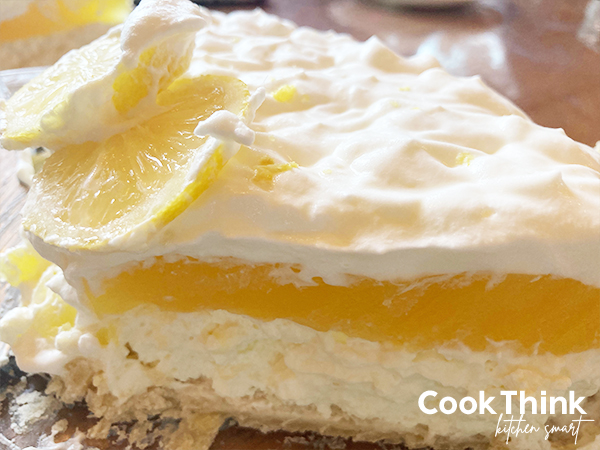Lemon zest can be a great thing to add bold lemon flavor to any recipe. Knowing how to zest a lemon can be beneficial for your culinary skills. We’ll go over the tools, as well as the process used, a variety of substitutes for lemon zest, and frequently asked questions.
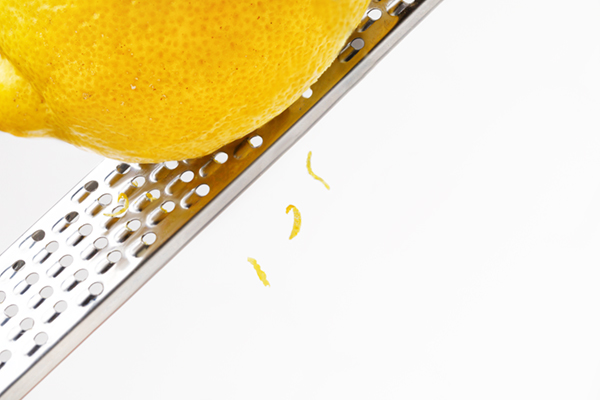
What is lemon zest?
Lemon zest is the yellow outside portion of a lemon’s peel. It can be used with or without lemon juice to add a nice zesty lemon flavor to a recipe. It can also be used as a garnish or decorative visual aspect for your food dishes.
What is lemon zest good for?
It can be used in a variety of recipes that have lemon flavor including cakes, pies, cookies, meats, and more. It provides a stronger lemon flavor than would be achieved in simply using lemon juice.
How do you make lemon zest?
To make lemon zest, a sharp tool is typically used to scrape the outside of the citrus peeling. There are a variety of ways that lemon zest can be made. We’ll go over several tools that can be used as well as methods for how to below.
Zest definition cooking
If you’re planning to make a recipe and you’re not sure what to zest culinary definition means, it is to remove the outermost skin layer of citrus such a lemons, limes, and oranges. The same is true for a zest cooking definition.
Definition of peel in cooking
The action of peeling in cooking generally refers to removing the outside skin of a fruit or vegetable. In the case of zesting a lemon, removing the outside peel typically involves finely grated lemon zest, or finely zesting it. It is the result from scraping the skin of a yellow citrus, that being a lemon.
What is in a lemon?
Inside a lemon, there are several parts that you’ll want to be familiar with when cooking with lemons.
The very outside of the lemon is called the rind. It creates the beautiful yellow color of a lemon.
Attached to the rind is the peeling. The peeling includes both the rind and the white outer jacket or white pith lemon that can be removed from the lemon’s flesh.
The next layer in is called the lemon flesh. This is where the lemon’s juice is stored.
Unless your lemon is seedless, there should also be seeds stored inside. These have the pattern to grow a new lemon tree if planted and nurtured in the right conditions.
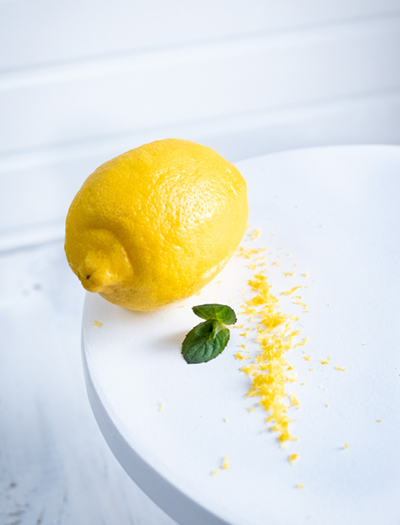
Rind vs Peel
When referring to rind vs peel in a lemon, you might wonder is lemon zest the same as lemon peel. Actually, in this case they’re two different parts of the lemon.
The rind refers to the extreme outer portion of the lemon. It is bright yellow in color. It can be removed from the lemon when it’s scraped.
The peel refers to the whole jacket that’s wrapped around the lemon flesh. It includes the rind as well as the white peeling that’s attached to the rind, all the way up to the flesh.
How much juice and zest in one lemon?
If a recipe refers to using the juice and zest of one lemon, you’ll probably want to know how much is the zest of one lemon. After all, it’s not common knowledge to know how much lemon zest in 1 lemon. Zesting results from scraping the skin of a yellow citrus.
Here’s the formula: How much zest in a lemon: One regular lemon yields about 1 tablespoon zest and 2 to 3 tablespoons juice.
Your recipe calls for zested and juiced lemon
There are many recipes that call for one zested and juiced lemon. If this is the case you’ll want to zest first, then juice. If you try to do them the other way around, zesting your lemon will prove to be difficult. Zest first, then juice.
How to use lemon peel
If you’re wanting to use up a lemon because you’re afraid it will go to waste shortly, there are so many good pie recipes, cakes, bars, cookies that can be made. See our lemon recipe suggestions at the bottom of this post for delicious ideas.
What to do with lemons after zesting
The best thing to do with lemons after they’ve been zested is to save the juice from it. Squeeze out all the juice from the lemon and then use it in your favorite tea, pie, cookies, or other favorite recipe that uses lemon juice. We’ve included our most popular lemon recipes at the bottom of this page.
How to zest and juice a lemon
To zest and juice a lemon, you’ll want to do it precisely in that order. Learning how to juice and zest a lemon can be a quality that will allow you to advance the flavor of dishes created. Real fresh lemon juice tastes so much better than concentrate that’s purchased in a bottle from the grocery store.
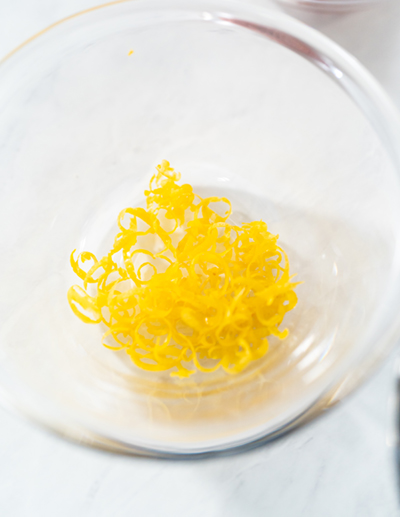
How to quarter a lemon
To quarter a lemon, use a lemon with rind. Wash it thoroughly first and then cut the lemon in half from the stem to the somewhat pointed end. Lay the two halves down on a hard surface with the flat sides down.
The cut each one again lengthwise from the stem to what used to be the point. You have now quartered a lemon and should have four equal pieces.
Best way to cut a lemon
The best way to cut a lemon depends on how the lemon will be used. Quartered lemons work great as a garnish for fish dishes because the juice can be easily squeezed onto the meat.
Sliced rounds of lemons work well and are visually attractive to use in hot teas and cold drinks like lemonade. Tiny bits of lemon work great for candied lemons. To consider the best way to cut a lemon, first decide how the lemon will be used.
Waxed versus unwaxed lemons
You might notice when you buy lemons at the grocery store, sometimes they have a shiny appearance. This is usually because your lemons have been waxed. This is to help preserve and protect the lemons as well as to enhance their appearance for purchase.
In order to easily zest a lemon, you’ll likely want to remove the wax from the lemons first. To know how to get wax off lemons, you’ll want to:
1. Bring a large pot of water to boil and pour the boiling water over the lemons. This will melt the wax.
2. Use a vegetable scrubbing brush to remove the was coating.
3. Wash and dry the lemons before zesting them.
Are organic lemons waxed?
Do organic lemons have wax? Yes, all organic lemons are unwaxed, but not all unwaxed lemons are organic lemons. Remove the wax before zesting lemons.
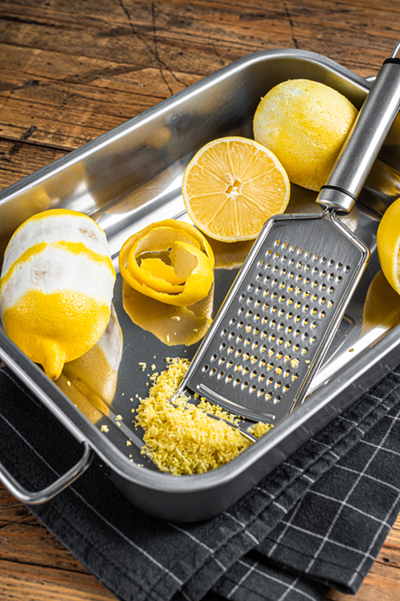
Can you buy lemon zest at the grocery store?
Yes, lemon zest is sold at most grocery stores in a dried form. It is usually sold alongside dried spices and herbs in the baking aisle.
How to store fresh lemon zest
If you’re into cooking from scratch or using lemon zest in a variety of foods, it’s important to know how to preserve lemon zest. There are multiple ways fresh lemon zest can be stored.
Refrigerator: If you plan to use the zest within a week’s time, just place it in a zipped food storage bag or place it in an airtight container in the refrigerator for use.
Freezer: To store lemon zest for up to 6 months, place it in a zipped freezer bag or airtight container in the freezer for use when you’re ready.
Pantry: Layer lemon zest with sugar in a sealed glass jar and place it in the pantry for future use.
How to cut lemon flavor
If your recipe calls for lemon flavoring such as lemon zest, lemon extract, or lemon juice, but you’re not too fond of lemon, simply cut the lemon flavor by decreasing the amount called for. Or completely eliminate it. That’s the beauty of making homemade food. You can custom make it according to your flavor preferences.
Lemon extract vs lemon zests
The difference between lemon extract and lemon zest is that extract is a condensed lemon juice that can be purchased in the baking section at your local grocery store. It has a stronger, bolder flavor that straight up lemon juice.
Lemon zest, on the other hand, is shredded skins from the outermost yellow portion its skin. It also has a bolder flavor because of the oils and flavor that reside in the rind of the lemon.
Zester vs grater
If you’re not sure about the difference between grater and zester or whether you should use a zester or a grater, to clear things up, a zester uses is made just for grating citrus. And a grater is made for multi-functional useage and grating a variety of foods.
If you’re using something like an all-in-one tool, such as a box grater, to know which side of a grater is the zester, it is usually the side with the smallest holes. A zester definition is a kitchen tool used to remove fine shreds zest from citrus.
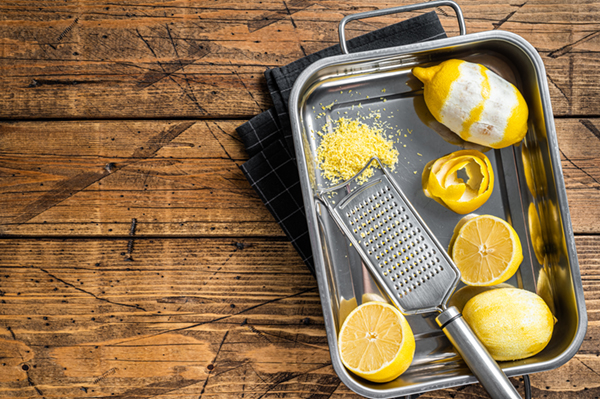
Can you use a cheese grater to zest a lemon?
Can you zest a lemon with a cheese grater? Yes, that will typically work fine in a pinch. Just keep in mind that you might need to use a sharp knife to mince the grated lemon afterwards, depending on the size of holes in your cheese grater.
Fancy ways to cut lemons
Following are some fancy ways to cut lemons to add an extra visual flair for your desserts and dishes. It can give a gourmet feeling that those who gather around your table are sure to enjoy.
How to make lemon twist
Lemon twists are a fun garnish for any drink. To know how to cut a lemon twist, you’re going to cut a lemon round slice, after washing the lemon.
Then, using a paring knife, cut just the outer skin off the round lemon slice.
If there is any of the white pith of lemon on the rind, scrape it off using a knife.
Finally, shape the lemon skin into a twist. This can be done using just your fingers. Or, you can wrap the skin around a long thin object such as a straw or chopstick and hold it there until it takes shape. And that’s it. That’s how to make a lemon twist.
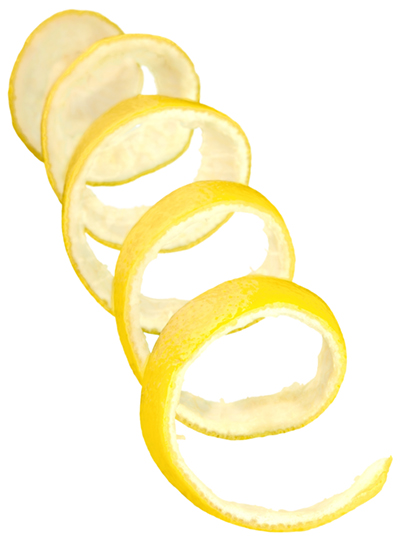
How to make a citrus twist
A citrus twist is made the same as a lemon twist. It can be made using the skin of citrus such as an orange, lemon, or lime. You don’t need a fancy bar tool for lemon twist nor do you need to buy a lemon twist tool.
To know how to make lemon curls, just use a pencil, straw, or chopstick to wrap the citrus skin around. It’s a great way to make a fun lemon peel garnish.
Is lemon zest a spice
If you’re shopping for it at the grocery store, you’ll likely find it dried and for sale in the spice section. Whether you consider lemon zest seasoning is a matter of opinion. But the fact of the matter is that it’s stronger in oils and flavor than the citrus itself.
Can you peel a lemon like an orange?
Yes, you can peel a lemon just like you would an orange. However, scarfing down a peeled lemon just like you would an orange might be more of quite a sour experience.
How to make orange zest at home
To make orange zest at home, there are a variety of tools that can be used to remove the zest from the orange. Those tools include a knife, box grater, vegetable peeler, citrus peeler, or microplane.
How to zest an orange with a cheese grater
To zest an orange using a cheese grater, use the smallest holes available on the grater. Wash the orange first, then using a firm grip on your orange, gently move it across the serrated holes, being careful keep your fingers back.
How to zest an orange with a knife
To zest an orange with a knife, use a sharp knife to remove small bits of the outermost portion of the orange skin of the fruit. Do not include the white layer that’s found between the outermost skin and the internal flesh of the fruit.
What is a strip of orange zest
A strip of orange zest is like a strip of orange rind or orange skin. It can be obtained by using a strip zester tool.
Orange zest strips can be used as a garnish for a variety of dishes. Strips of orange zest add visual interest as well as a gourmet feeling to food and drinks.
To create strip orange zest, use a strip zest tool such as a vegetable peeler or paring knife.

How much zest from one orange
The amount of orange zest that can be created from a single orange varies depending on the size of the orange. But the average orange usually creates about 2 to 3 tablespoons of orange zest.
What does it mean to zest a lime?
To zest a lime means to remove the outermost green colored skin from a lime, typically using a tool such as a lime zester. Lime zest recipes such as key lime pie require your fresh lime to be lime zested and juiced.
To zest a lime and obtain your grated lime peel, use the same instructions as we’ve included for how to zest a lemon. Don’t include the lime pith in your zest.
Another way to prepare limes is to zest and quarter lime for recipes that call for it prepared that way.
Can you buy lime zest?
Yes, lime zest tends to be available from online stores as well as some local specialty grocery stores.
Lime zest vs lemon zest
The main difference between lime zest and lemon zest is the slight difference in flavor as well as the difference in color. It is important to know that the two can be used as substitutes for one another in various recipes. And this it is possible to obtain lime zest without grater.
Substitutes for Lemon Zest:
Perhaps your recipe calls for lemon zest, but you don’t have a lemon available to you to zest. You’ve realized, oh no, I don’t have lemon zest what can I use? If that’s the case, you’ll probably want to find 1 lemon zest substitute. Here are some ideas:
Lemon Juice: Lemon juice can be a lemon rind substitute. It will allow you to maintain the same flavors in your dish, by using the same citrus. How much lemon juice equals lemon zest? For a lemon zest to lemon juice conversion, use 2 tablespoons of lemon juice in place of 1 tsp of lemon zest.
Lemon Extract: Substitute lemon extract for lemon zest. Lemon extract can usually be found in the baking section in most grocery stores. It is stronger than lemon juice so adequately helps to fulfill the job of lemon zest, without the lemony bits. Use lemon extract as a 1 to 1 substitute for lemon zest.
Lime Zest: Lime zest can be used as a substitute for lemon peel. Use lime zest as a 1 to 1 substitute for lemon zest. This means it can be used as an exact replacement, using the same amount as is called for as lemon zest in your recipe.
Lime Juice: Lime juice can be used as an adequate substitute for lemon zest. Use 2 tablespoons lime juice for 1 teaspoon of lemon zest. Lime juice will have a slightly different flavor than lemon, but in some cases, those who gather around your table will not be able to tell the difference.
Orange Zest: Orange zest can also work well as a zest of one lemon substitute. You can use orange zest as a 1 to 1 substitute for lemon zest. Orange zest works best as a replacement for lemon zest when it’s mixed into the recipe. The appearance will be altered as far as the color of the orange versus the yellow of the lemon if it’s used as a garnish.
Orange Juice: Orange juice is also a perfect substitute for zest of one lemon. It especially works well if it’s being added as a mixed in ingredient in a dish. Orange juice provides the proper citrus flavor needed to replace lemon zest. Use 2 tablespoons of orange juice in place of 1 tsp lemon zest.
Can you substitute lemon peel for lemon zest?
You might be referring to the same thing here. Just by way of clarification, the lemon zest should include just the extreme outside of the peeling. It’s what creates the yellow color of the fruit and has oils and flavors to enhance the lemon in the dish.
Grated lemon peel vs lemon zest
Lemon peeling includes both the skin of the lemon which is the outermost yellow colored portion of the lemon’s skin, plus the bitter white layer that comes between the skin and the flesh.
Lemon zest is solely the outer bright yellow skin. Technically speaking, it doesn’t include any of the bitter white layer that comes next.

Can I use lime zest instead of lemon zest?
Can I substitute lime zest for lemon zest? In some cases lime zest can be used instead of lemon zest. It boils down to a matter of personal preference for the particular dish, it’s used in as a flavoring or as a garnish. Can you substitute lime zest? Our answer is sure, if you’re okay for the slight tweak in flavoring.
Can I substitute orange zest for lemon zest?
Yes, you can use orange zest as a replacement for lemon zest, if you’re okay with the slight flavor alteration. Oranges tend to be sweeter than lemon. Therefore, the outcome of your dish using orange zest rather than lemon zest might be slightly sweeter. You can use the same ratio as called for in your recipe when substituting orange zest.
How to Zest a Lemon: 5 Methods
Following are our top 5 methods. These methods provide ease in the process of zesting a lemon technique as well as zesting a lemon method. They use tools that are typically found in a household kitchen or can be purchased without significant expense to add to a kitchen.
How to zest a lemon with a citrus zester:
To use a citrus rind peeler or specific citrus grater, begin by holding the tool by the handle. The other end should rest down on a cutting board or hard work surface. Hold the citrus with a firm grip keeping your fingers away from the grater. Move the citrus from the top of the grater to the bottom. Rotate the lemon and repeat this process until the entire rind of the lemon is removed.
How to zest a lemon with a microplane:
Hold the microplane grater side down and lightly drag it across the fruit. Each shave should remove a bit of the rind. Rotate the lemon and continue until the rind is removed.
If you’re not already familiar, here is a microplane definition. A lemon zester microplane is a long, thin metal tool that has a serrated edge used for grating a variety of food items and works great as a lemon zester.
How to zest a lemon with a vegetable peeler:
Keep in mind that there is a difference between peeling and zesting a lemon. And it’s possible to zest a lemon using a vegetable peeler. This method might prove to be a little more challenging but will get you through if you’re in a pinch.
Working with a vegetable peeler will result in larger pieces of zest, rather than fine little pieces that you’d achieve with a microplane. But that’s okay. Simply use your knife to chop them up into fine little pieces.
How to zest a lemon with a knife:
Zesting with a knife is another way that will achieve larger pieces of lemon zest. But if you don’t want them to be so chunky, just mince them into fine little pieces with your knife after you’ve removed them from the lemon.
When thinking about how to get lemon rind when zesting your lemon with a knife, be sure to only remove the outer most yellow peeling, rather than cutting down into the white portion of the peeling.
How to zest a lemon with a box grater:
Can you use a cheese grater as a zester? Sure. A box grater or a cheese grater both work well. In fact they’re one of our favorite tools. We like a box grater because they have nice sturdy handle and it doesn’t require us to store yet another tool in the kitchen cupboards. Use the finest panel on a box grater or cheese grater to do the job.
Fine grater vs zester
Is there a difference between a fine grater as opposed to a zester? In most cases, not much. So if you’re considering your budget and are not sure if you want to spring for a zester, use one of the other methods for zesting a lemon instead.
Save to Pinterest
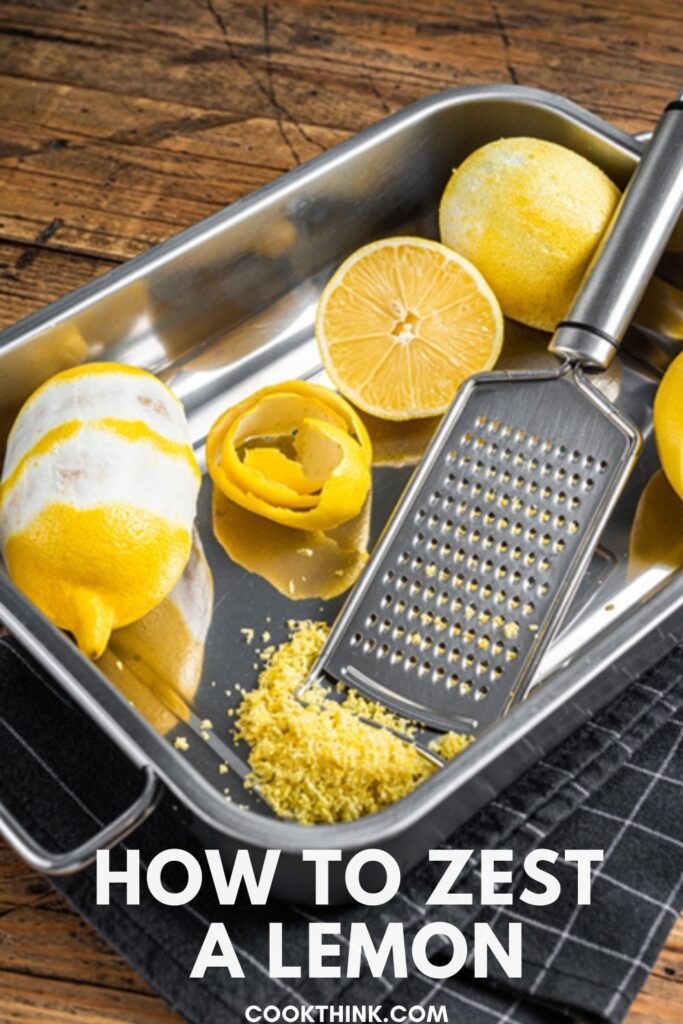
Recipe ideas:
Follow us on social media:
For more posts like this one, follow us on Pinterest, Facebook, Instagram and YouTube.




